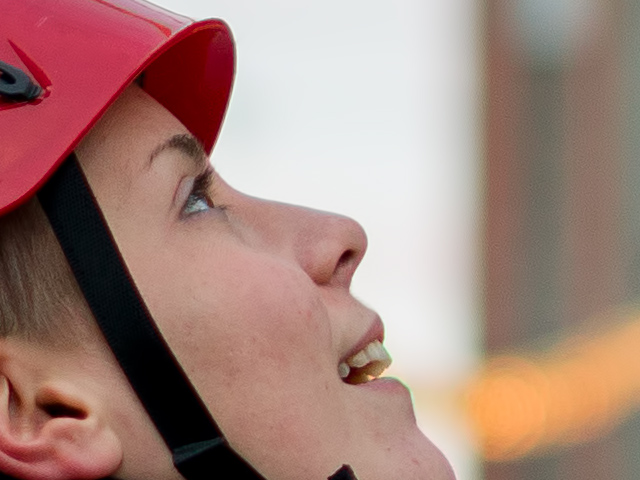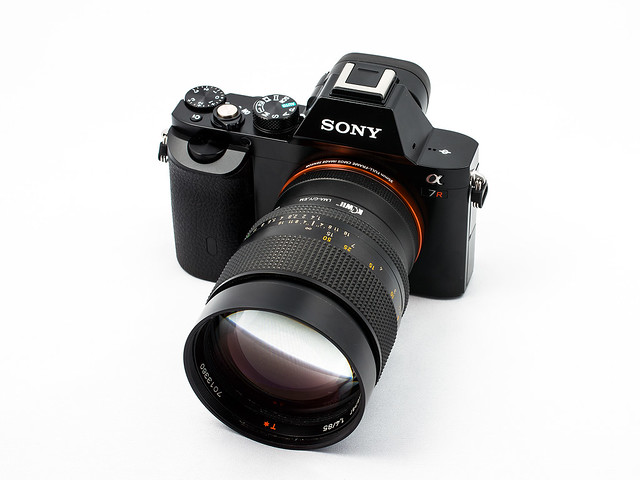Dec. 2013 - Since the new full frame mirrorless "ILCE" cameras (A7 and A7R) from Sony were presented in October, thanks to its small flange distance many users where thrilled by the option to adapt nearly every lens. In the wide angle range, there was quite a lot of frustration, but another article here shows some of the best options in the UWA range. In this article we will focus on lenses that give you great "virtual 3D" options to seperate objects by playing with depth of field (DOF) and beautiful bokeh.
This article will cover the following lenses (downwards sorted by focal length and maximum aperture):
- Sony STF 135mm f/2.8 T4.5
- Carl Zeiss Planar T* 85mm f/1.4 (with Contax/Yashica mount, MM version)
- Nikon AF-S Nikkor 85mm f/1.8 G (2012 model)
- Zeiss Otus APO Distagon T* 55mm f/1.4 (ZF.2 version)
- Zeiss FE Sonnar T* 55mm f/1.8 (not shown in the collection above)
- SLR Magic HyperPrime CINE 50mm T0.95
- Leica Summilux M 50mm f/1.4 ASPH
- SLR Magic HyperPrime CINE 35mm T0.95
- Voigtlander Nokton 35mm f/1.2 ASPH
- Voigtlander Ultron 21mm f/1.8 ASPH
135mm
Let us start right with an example from the Sony STF 135mm f/2.8 T4.5:

(click on image to see other sizes)
Due to its very specialized construction, this lens fascinated me since a long time but its focal length was a bit long when used on crop sensors (APS-C, FourThirds etc.). The full frame sensor of the Sony A7R changed the game...
This is, how it looks like on the Sony A7R:
From the photo above you can already see the double iris construction, from which the front one is designed to produce perfectly round shaped circles of confusion of hightlights outside the focal plane. Between the sets of aperture blades this lens has a special "apodization element", a kind of circular ND filter that reduces to its borders the intensity of light rays the more they are out of focus. This design gives an extremely smooth transition to the blurred out-of-focus regions and boosts sharpness inside the focal plane. If you are interested in more details about this masterpiece with a weight of 730g, you should take a look into this review: Sony 135 F2.8 [T4.5] STF SAL-135F28 review.
The achievement of this effort is visible in this 1:1 crop (100 actual pixels) from the portrait shown above:

As this lens is pureley manual, it can be adapted using a cheap A-Mount (or Minolta AF) to E-Mount adapter without electronic signal transmission. If you use this lens in low light situations, please be prepared that the apodization element absorbs some light, Sony evaluates its transmission to T4.5 when used at open aperture.
Some further examples taken with that lens demonstrating the usage of the front iris:
Transmission set to T4.5:
Transmission stopped down to T6.7:
Again fully open (f/2.8 / T4.5):
85mm
OK, time to go to get a bit closer with the next lens, the Carl Zeiss Planar T* 85mm f/1.4 (for Contax RTS / Yashica mount). There were two versions of that lens, the AE and the MM version, both weigh about 595g. From AE to MM version, mainly the shape of the aperture blades was changed, because blurred out highlights in images taken with the AE version stopped down looked somehow like circular saw blades. As long as you use the AE version wide open, there should be no noticable difference. The MM version can be identified by a green "16" on the aperture ring. This photo shows the lens mounted to the Sony A7R:
Some examples showing the characteristics of this lens - all taken with open aperture (f/1.4):
A video from these "girls on fire", that was recorded in major parts with the Zeiss 85/1.4 can be seen here:
Further examples at F1.4:
(click on the images to see other sizes)
If you want to travel a bit lighter but still with a bright 85mm lens, the Nikon AF-S Nikkor 85mm f/1.8 G (the new 2012 model) may be interesting for you as well. It weighs only 350g but has about the same size like the Zeiss Planar T* 85/1.4 shown above. To adapt it to the Sony A7(R) you need an adapter with an additional ring driving the mechanical aperture coupling. This is, how it looks on the A7R:
The lens produces a nice bokeh as well and is incredibly sharp right already wide open at F1.8:
To understand, what I mean with "incredibly sharp", look at this 1:1 crop (100% actual pixels):

Some further examples:
100% crop (actual pixels):

As both of these examples were shot with the Nikkor 85/1.8 under comparable conditions to the corresponding shots with the Zeiss 85/1.4 you can use their full resolutions (that you can reach by clicking on the images) for direkt comparison.
50 - 55mm
OK, time for the classical focal length, the "adorable 50s". We will start this range with the awesome Zeiss Otus 1.4/55, an apochromatic corrected Distagon design with Zeiss famous T' coating. It is used with manual focus, weighs about 1kg and the ZF.2 version (for Nikon mount) contains an additional aperture ring.
Here is a first shot at F1.4 (for comparison with the Leica Summilux 50mm f/1.4 ASPH see below):
...and a 100% crop (1:1 actual pixels):

The Otus shows an impressive resolution and micro contrast already at open aperture and delivers excellent results across the whole frame. You will see more from that formidable lens here at 3D-Kraft.com
Next candidate - also from Zeiss, also 55m focal length - is the brand new "native" full frame prime lense Zeiss FE Sonnar T* 55mm f/1.8:
Although there was a lot of praise already in advance, I was curious to see its quality by myself. When Sony says "what matters is having top quality in a 'not to big' sized lens" , this lens may be a good example. It is already very sharp used wide open with a beautiful and smooth bokeh and has a quick and accurate AF. Size and weight perfectly match the concept of the Sony A7/A7R.
Example at open aperture (F1.8), hand held at 1/60s:

"Schattenspringer" in action...
100% crop (actual pixels) from that shot:

Some more examples:
F5.6:
F1.8:
Although this article is more about bokeh, you may be interestedt in the sharpness across the whole frame of that lens at F5.6.

(click on the image to see other resolutions / sizes)
The next "adorable 50" is the SLR Magic HyperPrime CINE 50mm T0.95. This lens appeared early 2012 on the market in two versions. Both are optically and mechanically identical, have an M-mount and weigh about 1kg. The RF version is calibrated to be coupled on rangefinder cameras like Leica M9, MM or M240. Due to its extreme shallow depth of field, when shot at open aperture (and that's why you buy such a lens!) the summation of all tolerances may produce unwished results, so SLR Magic decided to offer this RF coupled version only directly in Hong Kong when you bring along your rangefinder camera for individual calibration of that lens to your particular camera. The CINE version does not require that elaborate procedure, so you can get it also shipped to other countries at a very attractive price compared to its competitor, the Leica Noctilux 50mm f/0.95 ASPH. There is a direct comparison between these lenses here on 3D-Kraft.
Some examples at open aperture (T0.95 / F0.92), shot hand held:
This is a 100% crop (1:1 actual pixels) from that image:

Some further examples, all at open aperture:
Playing around with backlight and flares:
Ok, time to stop down to F1.4 ;-) - a more compact alternative is the Leica Summilux 50mm f/1.4 ASPH, one of the most adored lenses in the Leica M system. It provides excellent center sharpness right from open aperture and one of the creamiest bokehs I have seen so far in the 50/1.4 sector.
Here are some examples at open aperture (F1.4):
Playing around in backlight with flares:
(click on the images for other sizes / resolutions)
Another bokeh comparison (comparable photos were show above with the Zeiss FE 55mm f/1.8).
F5.6
F1.4:
And another bokeh shot with the Leica Summilux at open aperture (no vignette correction) for comparison with the Zeiss Otus 1.4/55:
...and a 100% crop (1:1 actual pixels):

If you compare this image to the image from the Zeiss Otus 1.4/55 shown earlier, you see that both deliver excellent sharpness already at open aperture but the Otus delivers even more micro contrast and a significantly more evenly performance all over the whole frame (less vignetting than the Summilux, less field curvature).
35mm
Now let us take a look to some 35mm bokeh lenses. The most extreme contruction in this range is currently the SLR Magic HyperPrime CINE 35mm T0.95, available since March 2013. Although it comes with an M-mount, it is not designed to be used on a Leica M body or a Ricoh GXR M-mount modul, because its large rear lens element will not fit into their throat. It is meant to be used adapted to cameras with crop sensors like Sony NEX or Fuji X and depending on your order it will be shipped together with an adapter to that system. The idea here is to save your invest when you swap between these systems by just replacing the adapter. You can find an indepth review on Sony NEX-7 here at 3D-Kraft as well. Conquering The Darkness - SLR Magic HyperPrime CINE 35mm T0.95 Comparison.
So why did I decide to include such a crop lens design also in this article? The answer is given by these images which are only cropped to 4:3 aspect ratio and processed with some vignette reduction:
So you see, like no other 35mm focal length this lens provides you an incredible option to play with object sepration by depth of field with acceptable loss by cropping.
If you are searching for a 35mm lens that can be used without cropping and if you can live with "only" f/1.2 maximum aperture, the lens of choice for you may be the Voigtlander Nokton 35mm f/1.2 ASPH. In 2011 it was replaced in 2012 by a "version II". When I compared a sample of the new version to my previous version I sample, I decided to keep the version I but it may be possible that I only was unlucky to receive a bad copy of the version II lens (looking more "milky" at open aperture and with less creamy bokeh). This image demonstrates the different sizes:

(size comparison from left to right: SLR Magic HyperPrime CINE 35mm T0.95, Voigtlander Nokton 35mm f/1.2 ASPH II, Voigtlander Nokton 35mm f/1.2 ASPH I)
At the moment, I have only one shot takten with that lens on full frame (shot at open aperture):
If you are interested in further 35mm comparisons, but shot on APS-C crop (NEX-7), please look here: Adorable 35s - Big 35mm Speed Lens Comparison (Leica, SLR Magic, Mitakon, Canon + Speed Booster, Samyang)
21mm
Last but not least in this bokeh-maniac-series, is the Voigtlander Ultron 21mm f/1.8 ASPH. This is how it looks on the A7R:
This lens was already covered in more detail in my article about the "UWA lenses that work on Sony A7/A7R". So here I will only provide some examples taken at open aperture that demonstrate the options to play with DOF even at such a wide angle at an reasonable price (of course the Leica Summilux 21mm f/1.4 ASPH adds some bokeh options but it's price made me too dizzy...):
F1.8:

(click in the image to see other sizes. You may determine some field curvature with that lens)
Thanks to Kimi and Duo Flammenspuk!












































